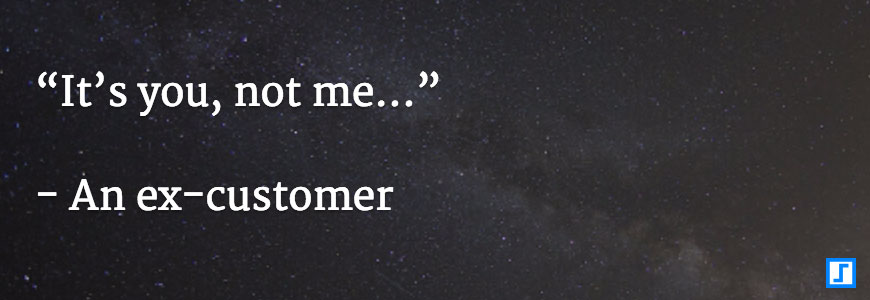I’ll have to admit, the very first time a customer left our service it escalated to a crisis at our company. As an entrepreneur, it was hard not to make it personal. After brainstorming to find answers, here are some reasons on why customers leave…
1. Relationships matter, a lot.
You might be providing B2B services, but business is really done between people. A new, untested product is usually sold on a promise and hope to an early adopter — your internal champion. Until the product has proven itself, the champion will have to face internal skeptics and is always afraid of looking bad in front of her peers. This champion acts as an advocate for your product to get the necessary adoption. If the relationship turns sour for any reason, there’s no reason to continue being an advocate for your product.
It’s not just a relationship turning sour, but the champion might no longer be in a position to be an advocate — usually as a result of a layoff or change of job responsibilities.
Story: Here’s what happened to a colleague who runs a company in a highly competitive space. One of their customers had a re-organization and the champion had a change of job responsibilities. The new person in-charge of the department that benefited most from their product was a fan of a competing product. One of the first things the new champion did was to put a migration strategy in place. There was nothing my colleague could do to save the customer. This scenario plays out more often than you think in competitive, undifferentiated markets with low switching costs.
2. Product Usage Data: Trust, but Verify.
If you have a customer that has been showing decreasing usage of your product over time, it’s a cause of concern. Your customers need to fire something else before they can hire your product. I think of it like a rebound relationship, as in they haven’t completely moved on from the old way of doing things. At this point your product is just a distraction. The insight here is that product usage doesn’t just drop off suddenly, it’s more gradual. Most times the champion doesn’t even know that their organization is not using the product.
Story: Another colleague works at a company that makes a CRM specialized for field-sales. Despite a fantastic relationship with the champion, they found that their sales reps were not using the product. Come renewal time, it was difficult for the customer to justify the investment in a product with a low adoption rate. As you would expect, the customer churned.
3. Poor or non-existant Onboarding.
Unfortunately most SaaS companies only think about closing the sale and are quick to escape the scene after the deal is done. A customer-centric way of thinking is to stick around after the deal has been inked and provide “concierge onboarding” to make your customer successful. This is a critical time in the customer lifecycle. The onboarding process is responsible for bridging the gap between the promise the customer was sold on and the actual value they get from the purchase.
Story: Some products are sold directly to executives, and a different set of users end up using the product. It’s common to use the terms “economic buyer” and “practitioner” to describe this scenario. One of the companies I’m familiar with is disrupting decades old processes with an innovative product. After the executive sign-off on the product, they found that the practitioner comes to the first kick-off call with a hostile attitude. After changing their onboarding process to include a “send a cake” step, they found it was easier to get the necessary traction to be successful.
The Takeaway
Poor relationships, low product usage and improper onboarding are the three main reasons your customers leave. Thus, addressing these will directly impact your customer lifetime value and the ability to grow your business.

